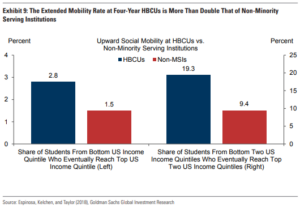Goldman Sachs has published a detailed report on how HBCUs can propel Black students toward greater social and economic mobility in a protected environment, despite being underfunded and admitting unprepared high school graduates.
The report comes just weeks before the Supreme Court decided to redact affirmative action and the debilitating implications it may have on Black and Hispanic students and society as a whole.
More from UB: Your next student cohort is visiting your website. Are you making a good impression?
Increasing student social mobility like none other
Colleges like Harvard announced how the decision on affirmative action would not waver its commitment to diversity. However, Politico illuminated how it is one of the 38 colleges to admit more students from the top 1% than the bottom 60%. Other colleges such as Dartmouth, Princeton, Yale, Penn and Brown share the same data point.
Goldman Sachs points to data from ACE suggesting HBCUs advance students from low-income families at a higher rate than non-minority-serving institutions. Specifically, the upward social mobility rate for students moving from the bottom two income quintiles to the top two is 10% higher at HBCUs than in non-minority serving institutions.

Inclusivity driving student support—and success
Black students at HBCUs reported higher rates of support from professors and related faculty than Black students at non-HBCUs. This is due to the more adequate proportion of Black professors to Black students at HBCUs than at predominantly white institutions (PWI). At HBCUs, for example, Black professors make up 55% of instructional staff compared to only 5% at non-HBCUs. The rate of Black professors at HBCUs more adequately matches the student rate at HBCUs, where Black students comprise 72% of their respective population.
“Faculty, staff, and administrators at HBCUs often know their students by their names and view student engagement as critical to their work, creating a safe space for Black students who are often victims of stereotypes that influence professors’ assumptions about their potential, intelligence, and ability to thrive,” wrote the authors of the report.
Additionally, with 60% of reported hate crimes in 2019 being fueled by race, negative campus assessments by Black students can affect their persistence and retention rates. With greater representation of Black students, however, Goldman Sachs found that the rate of race-based hate crimes decreases.
How to overcome HBCU roadblocks
Goldman Sachs attributes HBCUs’ historically meager budgets to underwhelming federal and state funding and a lack of strong private donations. Still, HBCUs can maintain their mission with a few guidelines detailed in the report.
- Continue to make endowment-building and fundraising an institutional priority. Choose board members who specialize in winning charitable donations and build more systemic engagement with all alumni rather than a network.
- Identify opportunities to market achievements and highlight the central role HBCUs play in higher education.
- Lean into transparency and accountability. Corporate donors expect acknowledgment of their contribution and a progress report on how it’s being used. These measures can help ensure that donors return.







